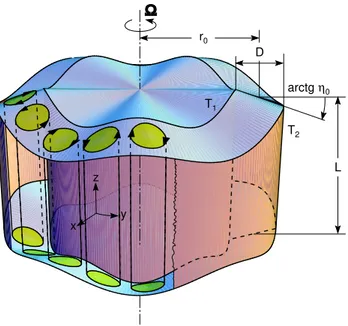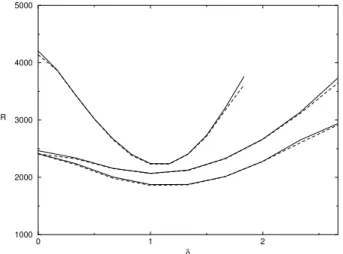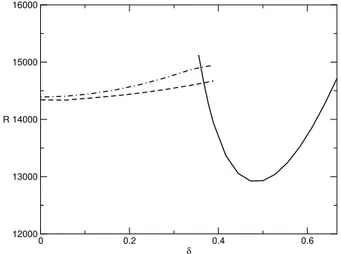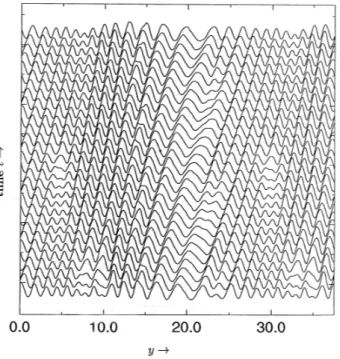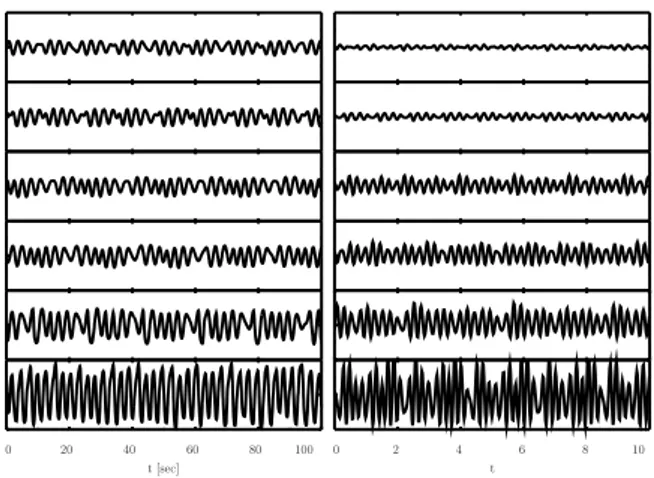Nonlinear Processes
in Geophysics
c
European Geosciences Union 2003
Centrifugally driven convection in the rotating cylindrical annulus
with modulated boundaries
M. Westerburg and F. H. Busse
Institute of Physics, University of Bayreuth, D-95440 Bayreuth, Germany
Received: 18 June 2002 – Revised: 17 October 2002 – Accepted: 21 October 2002
Abstract. The effect of sinusoidally modulated conical end boundaries on convection in a rotating cylindrical annulus is investigated theoretically and experimentally. A quasiperi-odic time dependence of convection in the form of thermal Rossby waves is found and semi-quantitative agreement be-tween theory and measurements can be established. The re-sults are relevant to convection in the Earth’s outer core close to the tangent cylinder touching the inner core at its equator.
1. Introduction
Convection driven by centrifugal buoyancy in a rotating cylindrical annulus has become one of the basic fluid dy-namical systems in which the interactions between buoyancy driven flows and rotation can be studied in their simplest re-alizations. In particular, the annulus model exhibits all basic dynamical features of convection in rotating spherical shells which represents a fundamental problem in astrophysics and planetary science. The rotating annulus system can easily be realized in the laboratory (Busse and Carrigan, 1974) and several experimental studies have been performed (Azouni et al., 1986; Busse et al., 1997). Among the theoretical in-vestigations we mention only some recent ones (Schnaubelt and Busse, 1992, 1997), in which realistic no-slip boundary conditions have been used.
While the annulus system as well as the spherical shell are usually considered as axisymmetric systems the influence of non-axisymmetric modulations of the boundaries has re-ceived much attention in recent years. In the geophysical context the effects of bumps on the core-mantle boundary of the Earth have been considered for a long time (Hide, 1989) and have motivated the recent analysis by Bassom and Soward (1996) and Soward and Bassom (1997). The anal-ogous problem for the rotating cylindrical annulus has been treated by Bell and Soward (1996, see also Bell, 1993) and
Correspondence to:M. Westerburg (Michael.Westburg@uni-bayreuth.de)
by Herrmann and Busse (1998). In the present paper an ex-perimental investigation of the modulated annulus problem will be reported. Since the previous theoretical studies have been done for a parameter range that is not easily accessi-ble in the laboratory, we also shall describe some numerical computations which show a close correspondence with the experimentally observed phenomena.
The problem of convection in the presence of a spatial modulation is also of interest from a basic physical point of view. Numerous papers have been published on the effect of modulated boundary conditions on Rayleigh-B´enard con-vection in a horizontal fluid layer heated from below (Kelly and Pal, 1978; Pal and Kelly, 1978; Hartung et al., 1990, 1991; Zimmermann et al., 1998; and others referred to in these papers). The analysis of the Rayleigh-B´enard problem in the case of sinusoidal variations of the height of the layer or of the temperature prescribed at the boundaries is ham-pered by the fact that the basic state is no longer a motionless state. This property, however, can be preserved in the case of centrifugally driven convection in the rotating cylindrical annulus. The latter problem is also richer than the problem of modulated Rayleigh-B`enard convection because convection assumes the form of traveling thermal Rossby waves. There are thus various kinds of time dependent forms of convection besides the steady mode locked to the modulated boundary.
arctg η0 D
L r0
T1
T2
z
x
y
Fig. 1. Geometrical configuration of the rotating modulated cylin-drical annulus.
Rossby waves and propagate in the azimuthal direction given by∇h×whereis the rotation vector of the system. A modulation of these waves occurs when the height varies also in the azimuthal direction as indicated in Fig. 1. This mod-ulation breaks the azimuthal symmetry, but it still admits a motionless basic state. This feature simplifies the analysis of the convection flow and also makes the system attractive from the experimental point of view.
In the following we shall briefly introduce the theoreti-cal description of the problem in Sect. 2 and describe some results of the linear analysis for the onset of convection in Sect. 3. The nonlinear properties of convection in the form of propagating thermal Rossby waves are discussed in Sect. 4. In Sect. 5 the laboratory apparatus and the measurement tech-niques are briefly described and experimental results are pre-sented. A concluding discussion is given in the last section of the paper.
2. Mathematical formulation of the problem
We consider the modulated cylindrical annulus of average height Las shown in Fig. 1. The temperatures T1 andT2
are prescribed on the inner and outer cylinders, respectively, and the entire configuration is rotating rigidly with the an-gular velocityabout its axis. Using the gap widthD as length scale andD2/νas time scale whereνis the kinematic viscosity of the fluid, we arrive at the following system of equations for the stream functionψ and the deviation2of the temperature from the static state of a purely conducting profile,
∂
∂t + ∂ ∂yψ
∂ ∂x −
∂ ∂xψ
∂ ∂y −12
12ψ−η
(1+δcosαMy)
∂
∂yψ+ǫsinαMy ∂ ∂xψ+R
∂
∂y2=0 (1a) P
∂
∂t + ∂ ∂yψ
∂ ∂x−
∂ ∂xψ
∂ ∂y
2−122+ ∂
∂yψ=0 (1b)
where12≡∂2/∂x2+∂2/∂y2and where the Rayleigh
num-berR, the Prandtl numberP, the Coriolis parameterηand the dimensionless modulation parametersδandεare defined by
R= γ (T2−T1)
2r 0D3
νκ , P = ν κ, η=
4η0D3 νL , δ= 2ǫDˆ
L , ǫ=
4ǫαˆ MD3
νL (2)
Here γ is the coefficient of thermal expansion, κ is the thermal diffusivity and r0 is the mean radius of the
annu-lus. αM is the wavenumber of the modulation as defined in expression (3) below. A Cartesian coordinate system has been introduced with thex, yandz-coordinates oriented in the radial, azimuthal and axial directions, respectively. The terms involvingη, δandǫarise when the equation for thez -component of vorticity,12ψ, is averaged over the height of the annulus and the condition that the normal component of the velocity vanishes at the modulated boundaries
z±= ±
L
2D ∓η0x∓ ˆǫcosαMy (3)
has been taken into account together with the assumptions
η0 ≪ 1,ǫˆ ≪ L/D. Through this procedure it has been possible to reduce the original equations for the three-dimensional velocity field(vx, vy, vz)to an equation for its dominating two-dimensional geostrophic component, vx =
∂ψ/∂y, vy= −∂ψ/∂x, described by the stream functionψ. For a more detailed discussion of the problem without mod-ulation we refer to Busse (1986). The problem with modu-lation has been treated in the limitδ =0 by Herrmann and Busse (1998), which will be referred to by HB98 in the fol-lowing. An earlier analysis of the problem based on periodic boundary conditions in thex-direction has been given by Bell and Soward (1996; see also Bell, 1993). In the present anal-ysis we shall focus the attention on the caseǫ = 0, δ 6= 0 which has not been considered previously, but is close to the experimental situation.
In order to solve Eqs. (1) in the experimentally realistic case of no-slip cylindrical boundaries at which the conditions
∂ ∂yψ=
∂
∂xψ=2=0 atx= ±
1
2 (4)
are imposed, we introduce the Galerkin representation
ψ= ∞ X
l=1,n=0
(aˆln(t )cosnαy+ ˇaln(t )sinnαy)
fl(x)+(4x3−3x)aˆ00(t ) (5a)
2=X l,n
where the functionsfl(x)denote the Chandrasekhar func-tions
fl=
coshλlx
coshλl12
−cosλlx
cosλl12
for l= odd
sinhλlx
sinhλl12 −
sinλlx
sinλl12 for l= even
(6a)
The numbersλlare obtained as the roots of the equations tanhλl
1
2 +tanλl 1
2 =0 forl=odd, cothλl
1
2− cotλl 1
2 =0 forl= even (6b)
By adding the last term on the right hand side of expression (5a) we have accommodated the fact that a vanishing zonal mass flux through the annulus cannot be required and thus the conditionψ = 0 atx = ±12 must not be used for the
y-independent part ofψ. Instead the consequence of the ab-sence of a mean pressure gradient in the azimuthal direction must be considered. This latter condition is satisfied when ˆ
a00(t )obeys the equation ∂
∂ta00(t )ˆ = −
X
l=even ˆ
al0(t )fl′′( 1
2)−12a00(t )ˆ (7) After expressions (5) have been introduced in Eq. (6) and these have been projected onto the sets of expansion func-tions used in Eq. (5), a system of nonlinear differential equations in time are obtained for the unknown coefficients ˆ
aln(t ),aˇln(t ),bˆln(t ),bˇln(t ). Through numerical forward in-tegration in time this system of equations can be solved once it has been truncated. By neglecting all coefficients and cor-responding equations with subscriptsl, nwhich satisfy either one of the conditions
l > Nx , n > Ny (8) we obtain a finite system. A typical value used forNx is 6, but much larger values up to 63 have been used forNy depending on the ratio between αand αM. Various other truncation values have been used in order to ensure that all physically relevant properties of the solutions change only in-significantly whenNxandNyare replaced byNx+2,2Ny+ 1.
3. Onset of convection
For the determination of the onset of convection based on the linearized version of Eq. (1), we use the Floquetansatz ψ=exp{idy+σ t}X
l,n
alnexp{inαMy}fl(z) (9a)
2=exp{idy+σ t}X l,n
blnexp{inαMy}sinlπ(x+ 1 2) (9b) The solution of the linear algebraic eigenvalue problem for the eigenvalueσwill determineσas a function ofdfor given values ofR, δ, αM, η, P. Whenever there exists a positive
0 1 2
δ
1000 2000 3000 4000 5000
R
Fig. 2. Critical Rayleigh numberRc for onset of convection as a function ofδin the casesη=600 withαM = 1.0, η=300 with αM=1.0 and withαM=0.5 (from top to bottom). For each of the three cases the results for vanishing Floquet wavenumber,d = 0 (solid curves) and for finite values ofd(dashed curves) are shown. P =0.71 in all cases.
real partσr ofσ, the static state of pure conduction is unsta-ble, otherwise it will be regarded as stable. It is a demanding task to investigate the full five-dimensional parameter space spanned by the parametersR, δ, αM, η, P and we shall re-strict the analysis to a few special cases.
In Fig. 2 results for the onset of convection are shown for modulations with relative long wavelengths,αM = 0.5 and 1.0. The system exhibits a local response in that the onset of convection occurs where the expression η(y)ˆ ≡
η(1+δcosαMy)reaches a minimum. The critical Rayleigh numberRc thus decreases with increasingδ and reaches a minimum whenδapproaches unity. Beyond that pointη(y)ˆ becomes negative in finite intervals of y andRc increases again since a zero-crossing ofη(y)ˆ does not provide the same optimal conditions for the onset of convection as the place whereη(y)ˆ touches zero. Since in experimental realisations only discrete wavelengths are admissible in the azimuthal di-rection we have indicated in Fig. 2 Rayleigh numbers for the cased = 0 as well as for the minimizing value of d. Obviously there is no significant difference between the two types of curves in the case of smallαM. Ford =0, for in-stance, dominating coefficients in expressions (9) are found forl =1, n=3 in the caseαM =1.0 and forl =1, n=7 in the caseαM =0.5. When finite values ofd are admitted,
d ≈0.5 andd≈0 are found in the two cases.
0 0.5 1 1.5 2
δ
2000 3000 4000 5000 6000
R
Fig. 3. Critical Rayleigh numberRc for onset of convection as a function ofδin the caseη= 600 withαM = 3.0 andP = 0.71. The dotted (dash-dotted) curve corresponds to the onset of thermal Rossby waves with finite (vanishing) value ofd. The solid curve corresponds to the steady pinned mode of convection.
Bell (1993; see also Bell and Soward, 1996) and was investi-gated in HB98 for realistic boundary conditions. ForαM ≃3 the critical Rayleigh number exhibits a very wide minimum. But asαM decreases the minimum becomes rather sharp as shown by the example of Fig. 4. For a more systematic study of this behavior see HB98. Because the emphasis of this pa-per is on the nonlinear aspects of the problem we shall close the consideration of the linear problem at this point and men-tion only that the results for the steady mode hold indepen-dently of the Prandtl numberP sinceP appears only in con-nection with the time derivative of2in the linear version of Eq. (1).
4. Nonlinear analysis of convection
Solutions of the fully nonlinear system of Eq. (1) are ob-tained through the Galerkin representation (5). Since the modulation wave numberαM is usually much smaller than the natural wavenumber of the thermal Rossby waves a much higher truncation is used for the indexnthan for the indexl
in expressions (5) and the associated system of ordinary dif-ferential equations in time for the coefficientsaˆln(t ),aˇln(t ),
ˆ
bln(t )andbˇln(t ). Usually truncationsl ≤6 or 8 andn≤32 have been used as we have already mentioned above.
A typical result of the computations is shown in Fig. 5 where the evolution of the amplitude of the modulated Rossby waves is shown as a function of time. At the point
y=0 the expression 1+δcosαMyreaches its maximum and thus the inhibiting influence of rotation is especially strong. The thermal Rossby waves entering from the left thus decay in amplitude as they propagate towards the right. Because the local value of the phase velocity also reaches a maximum aty = 0 the lines of constant phase are most strongly in-clined at this point. The opposite behavior can be observed
0 0.2 0.4 0.6
δ
12000 13000 14000 15000 16000
R
Fig. 4.Same as Fig. 3 but forη=1800 withαM=1.0.
aty =π/αM where the local constraint of rotation reaches a minimum. The thermal Rossby waves thus slow down and increase in amplitude as they propagate.
For the comparison with experimental observation it is of interest to follow the time dependence of a variable, say the temperature, at a fixed point in space. In Fig. 6a typical set of traces in time are shown which demonstrate the na-ture of time dependence may change significantly from one point to a neighboring one. Especially at the stations where | sinαMy | is large such that the local value ofηchanges most rapidly the time dependence is characterized by the decaying long wavelength part and the growing short wave-length part of the Rossby waves (for sinαMy <0) and vice versa (for sinαMy > 0). The trains of Rossby waves are more regular shortly after cosαMy reaches its maximum or minimum.
5. Experimental observations
Convection driven by centrifugal buoyancy in a rotating cylindrical annulus can be realized in relatively simple ways in laboratory experiments. The action of gravity is mini-mized when a vertical axis of rotation is used and the rate of rotation is chosen sufficiently high such that the centrifu-gal force exceeds that of gravity by a factor of two or three. Reports on results from experiments with axisymmetric an-nulus configurations can be found in the papers by Busse et al. (1997) and references therein and by Jaletzky and Busse (2000). The drawing shown in Fig. 1 of the latter paper in-dicates details of the apparatus which has been modified in order to realize an annular region as indicated in Fig. 1. Two aluminum cylinders have been used to create a fluid gap of thicknessD =10.4 mm with a mean radiusro=70.2 mm. Conical end boundaries with the angle arctgη0=π/4 are
in-troduced which are modulated in the azimuthal direction with the azimuthal wavenumberm=2 and with an amplitude of
Fig. 5. The temperature2at the pointx = −0.4 as a function of yat different instances in time,t = t0+n1t,nincreasing from
bottom to top with1t = 0.06, in the caseR = 3000,η = 300, αM =0.25,δ=0.3,P =0.71.
gap is kept variable. But usually relatively low values have been used in order to reach high values ofηandδfor which the modulation effects become most clearly visible. This lat-ter goal conflicts, of course, with assumption ofǫˆ ≪ L/D
on which the theoretical analysis is based. Discrepancies be-tween theoretical predictions and measurements must thus be expected. Differences between theoretical calculations car-ried out forǫ=0 and experimental observations should also be anticipated becauseǫis not negligible in the experiment. The effect ofǫon the dynamics of thermal Rossby waves is comparable to, though somewhat weaker than the effect of
ηδas can be seen from a comparison of the results of Figs. 2 and 3 with those given in HB98. In the experimentηδ ≈2ǫ
holds and thus some influence of the finite value ofǫmust be expected.
The existence of thermal Rossby waves is detected by ther-mistors imbedded in the wall of the inner cylinder at its equatorial plane. The tiny thermistors (with a diameter of 0.41 mm from Bowthorpe Thermometrics) with a resistance of 10kat 25◦C glued into little holes in the aluminum wall such that they reach up to a distance of 0.5 mm into the fluid. This distance is small enough to avoid any significant distur-bance of the flow, but improves the detection of temperature variations. The resistance of the thermistors is measured by digital multimeters (PREMA) to which they are electrically connected through slip-rings. Most of the experiments have been carried out with air as fluid. More accurately it should be said that nitrogen had been used instead of air in order to avoid the problem of eliminating the water vapor from the
0.0 2.0 4.0 6.0 8.0 10.0
t ->
Fig. 6.Time dependence of the temperature2(x, y, t )atx= −0.4 and at the valuesy = 2·mwithm= 0,1, . . . ,12 (from bottom to top) in the caseR=4000, η=300, αM =0.25, δ=0.4, P = 0.71.
air. Since the properties of nitrogen and dry air are nearly the same we shall neglect the differences between the two fluids. Some experiments have also been carried out with water.
Examples of the thermistor records are shown in Fig. 7. These records have been high-pass filtered since slight vari-ations in the temperatures of the thermostats caused long pe-riod variations of the order of several 10−2K in the tempera-tures of the aluminum walls. The thermistor records of Fig. 7 clearly demonstrate how sensitively the structure of the sig-nal depends on the position of the thermistor. The values of the Rayleigh number referred to in the figure caption repre-sent overestimates since the heat transport provided by con-vection has not been taken into account in calculating the temperature difference between the walls.
As mentioned before the assumptions of the theory are not well approximated in the experiment. Moreover, the rapid change with position of the temperature signal adds to the difficulty of a quantitative comparison between theory and experiment. It is thus not surprising that only certain qual-itative features are captured in the attempt of a comparison shown in Fig. 8.
6. Discussion
depen-0
0 10 20 10 200 10 20 30 40 50
t[se℄ t[se℄
t[se℄
Fig. 7.Temperature close to the inner wall of the modulated cylin-drical annulus as recorded by thermistors at the positions y = −6.1,−0.8 and+0.6 (from left to right) in the caseη=458, δ = 0.45, P = 0.71. The Rayleigh numbers (calculated without con-sideration of the convective contribution to the heat transport) are 9003, 10033, 11007, 12012, 12915, 13795 (from top to bottom).
2 4 6 8 10
20 40 60 80 100
0 0
t[se℄ t
Fig. 8.Comparison of time dependences of temperatures measured by a thermistor at the positiony = 4.7 with temperature depen-dences at the samey-position(x= −0.4)obtained from numerical simulations in the caseη = 458, δ = 0.45, αM = 0.296. The Rayleigh numbers used in the simulations are 2385, 3500, 3600, 3900, 4000, 4250, 4500 (from top to bottom).
dence of the modulated thermal Rossby waves agrees semi-quantitatively with the theoretical predictions.
The purely sinusoidal modulation studied in this paper has no direct geophysical application. It can be concluded, how-ever, that the topography of the core-mantle boundary will affect convection in the form of thermal Rossby waves signif-icantly only close to the virtual surface of the tangent cylin-der which touches the inner core at its equator. At larger dis-tances from the axis of rotation the geostrophic contours are not interrupted and dynamical features such as those studied in this paper can not be expected. Of course, Lorentz forces which have been neglected in the present study may also play a role in the Earth’s core. But this topic should be addressed in another paper.
Acknowledgement. The support of the Deutsche Forschungsge-meinschaft for the research reported in this paper is gratefully ac-knowledged. The authors are also indebted to A. Busse for her help in the production of the figures.
References
Azouni, A., Bolton, E. W., and Busse, F. H.: Experimental study of convection columns in a rotating cylindrical annulus, Geophys. Astrophys. Fluid Dyn. 34, 301–317, 1986.
Bassom, A. P. and Soward, A. M.: Localized rotating convection induced by topography, Physica D 97, 29–44, 1996.
Bell, P. I.: The effects of bumps on convection in the Earth’s core, PhD thesis, University of Newcastle upon Tyne, 1993.
Bell, P. I. and Soward, A. M.: The influence of surface topography on rotating convection, J. Fluid Mech. 313, 147–180, 1996. Busse, F. H.: Asymptotic theory of convection in a rotating
cylin-drical annulus, J. Fluid Mech. 173, 545–556, 1986.
Busse, F. H. and Carrigan, C. R.: Convection induced by centrifugal buoyancy, J. Fluid Mech. 62, 579–592, 1974.
Busse, F. H., Hartung, G., Jaletzky, M., and Sommermann, G.: Thermal Convection Driven by Centrifugal Buoyancy in the Lab-oratory and its Applications to Planetary Problems, Dyn. Atmo-spheres Oceans 27, 161–174, 1997.
Hartung, G., Busse, F. H., and Rehberg, I.: Drifting convection rolls induced by spatial modulation, in: “Nonlinear Evolution of Spatio-Temporal Structures in Dissipative Continuous Systems”, (Eds) Busse, F. H. and Kramer, L., Plenum Press, New York, 61–65, 1990.
Hartung, G., Busse, F. H., and Rehberg, I.: Time-dependent con-vection induced by broken spatial symmetry, Phys. Rev. Letts. 66, 2742–2745, 1991.
Herrmann, J. and Busse, F. H.: Stationary and time dependent con-vection in the rotating cylindrical annulus with modulated height, Phys. Fluids 10, 1611–1620, 1998.
Hide, R.: Fluctuations in the Earth’s rotation and the topography of the core-mantle interface, Phil. Trans. R. Soc. Lond. A328, 351–363, 1989.
Jaletzky, M. and Busse, F. H.: New patterns in centrifugally driven thermal convection, Proc. Nat. Acad. Sci. 97, 5060–5064, 2000. Kelly, R. E. and Pal, D.: Thermal convection with spatially pe-riodic boundary condition: resonant wavelength excitation, J. Fluid Mech. 86, 433–456, 1978.
Pal, O. and Kelly, R. E.: Thermal convection with spatially peri-odic nonuniform heating: nonresonant wavelength excitation, in: “Heat Transfer 1978” (Proc. VI Int. Heat Transfer Conf.), 2, 235– 238, 1978.
Schnaubelt, M. and Busse, F. H.: Convection in a rotating cylindri-cal annulus. Part 3. Vacillating and spatially modulated flows, J. Fluid Mech. 245, 155–173, 1992.
Schnaubelt, M. and Busse, F. H.: Thermal Convection in the Rotat-ing Cylindrical Annulus, Acta Astron. et Geophys. Univ. Come-nianae 19, 63–78, 1997.
Soward, A. M. and Bassom, A. P.: Topographic rotating convection, Acta Astron. Geophys. Universitatis Comenianae 19, 277–292, 1997.
